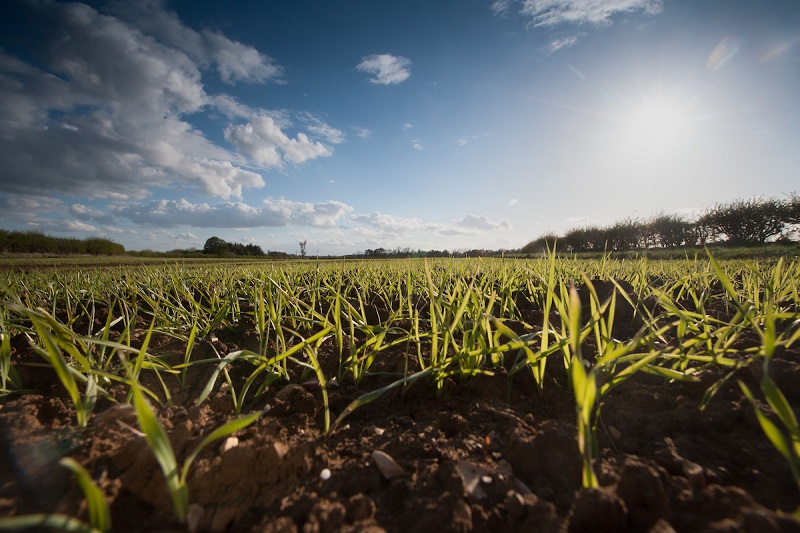The subject of biostimulants is one of those that divides opinion. Some growers and agronomists are exploring their potential, while others have reservations and are waiting to be convinced, and some may even have given them a go and seen no benefit.
Whichever camp you may fall into, there’s a growing dataset behind Interagro’s amino-acid product, Bridgeway, that’s beginning to tell its story, says Stuart Sutherland, technical manager at Interagro.
“The end of year report for the Cereal YEN Farmer Innovation Trials concluded that amino acid biostimulants could do better – citing a distinct lack of field evidence, and little or no independent data in cereals and oilseed rape crops.
“Furthermore, 2018 trials reported -0.26 to +0.5 t/ha yield benefit and 2019 trials showed -0.47 to +0.18 t/ha yield affect. It’s a picture that on the face of it isn’t very exciting, and no doubt disappointing.”
However, after three years of replicated field trials and commercial tramline trials, with 41 data points in winter wheat to compare against, the picture is brighter for Bridgeway, he adds. “The data reveals an average yield benefit of +0.35 t/ha in trials spanning from 2017 to 2019, with a range of -0.30 to +3.0 t/ha increase in yield – the upper end in the stressful growing periods of 2017 and 2018.”

The results have guided Interagro’s position for 2020, with the firm stating that applications of Bridgeway – and sister product Zonda – are best suited to help prevent abiotic stress or help crops recover from stress, at least in cereals, adds Stuart. “Bridgeway and Zonda are stress-busting solutions and it’s in these situations where yield benefits should only be expected.”
April and May were stressful periods for crops in 2017 and 2018, with temperature and moisture stress clearly impacting yield in cereals. “March 2017 was the fifth warmest on record, and April recorded only 30% of the typical rainfall,” says Stuart. “Cereal crops were under stress at the critical stem extension/T1 stage.
“March 2018 was the seventh wettest on record, with the Beast from the East and Storm Emma followed by a cold start to April, and then the hottest April day on record since 1949 by the end of the month.”
May then turned exceptionally sunny and dry, meaning many cereal crops would have been under high levels of stress, and in both 2017 and 2018 Interagro saw excellent yield benefits from applying Bridgeway in a range of situations on farm, highlights Stuart. “Conversely, 2019 saw the fifth wettest March on record, April started warm and cool followed by more settled conditions, and May saw a mix of showers and warm sunny weather – 2019 wasn’t a stressful year for most cereal crops.
“As a result, cereal crops were less responsive to Bridgeway. Only in stressful growing situations did Bridgeway benefits translate into yield.”
With more experience under their belts and a wealth of data to call upon, Interagro believes the results they have in cereals indicate that Bridgeway is one of the best solutions for stressed cereal crops.
“When applying any type of product to a crop it’s important to know what you’re trying to achieve and why,” says Stuart. “A crop can produce all the amino acids and peptides it needs in ideal conditions. It’s only when the raw materials – water, oxygen, nitrogen and carbon dioxide – diminish, or the crop is stressed, that the production slows or stops.
“A biostimulant acts like a supplement until the crop can start production again.”
Interagro’s advice for this year is to tailor any amino acid biostimulant applications in cereals (and oilseed rape) to the field situation, rather than prescribing a standard programme. “Ideally the applications should be applied just before the stress period in order to supplement amino acid and peptides as crop production slows,” adds Stuart. “We know that peptides can aid recovery and therefore, if growers have not applied before a stress event, applications should be made immediately after.
“Of course, none of us have a crystal ball so it’s hard for growers to know when the crop is stressed and when to make the application.
“It’s a similar conundrum to low/high input fungicides or PGR programmes – do you take the insurance route or minimise the investment?
“While they don’t always payback, in the right situations they can really pay-out.”
Crop recommendations based on field evidence:
Spring cereals
After one of the wettest autumns/winters on record, it’s perhaps slightly ironic that rainfall could now become a limiting factor in yield potential, with spring cereals at risk of moisture and nitrogen stress, explains Stuart.
According to Interagro, Bridgeway or Zonda 1.0-2.0 l/ha from growth stage 14 can:
- Stimulate root and shoot growth
- Aid water and nutrient uptake
- Limit impact of abiotic stress
- Boost establishment For
Winter cereals
With some winter crops now feeling the effects of the dry conditions, an application of Bridgeway or Zonda could help to keep winter crops stress free in order to protect yield potential, says Stuart.
According to Interagro, Bridgeway or Zonda 1.0-2.0 l/ha from growth stage 30 onwards can:
- Limit impact of abiotic stress (a trigger for ramularia in barley)
- Reduce scorch from liquid nitrogen
- Increase water and nutrient uptake
- Reduce brackling in barley
- Protect yield potential in stress situations
- Add significant yield increases in high stress conditions
Sugar beet
It’s well known that there’s a strong correlation between harnessing light energy and final yield in sugar beet, notes Stuart. “Early applications of Bridgeway or Zonda from 2-true leaves will increase chlorophyll production, critical for photosynthesis and sugar production.”
According to Interagro, Bridgeway or Zonda 2.0l/ha from 2-true leaves can:
- Limit abiotic stress
- Improve access to water and nutrients
- Aid recovery from herbicide scorch
- Protect yield, increase sugars and add significant margin increases
Case studies
Further evidence of efficacy in the field can be found within the following case studies:
Stress busting year after year
https://www.interagro.co.uk/case-study/stress-busting-solutions-with-bridgeway-and-zonda/
Stress at key T-timings in feed wheat
https://www.interagro.co.uk/case-study/bridgeway-improved-yield-in-winter-wheat/
Stress – Bridgeway helped achieve milling specification in winter wheat
https://www.interagro.co.uk/case-study/bridgeway-helped-achieve-milling-specification-in-winter-wheat/
Two-year review by CMI Ltd:
https://www.interagro.co.uk/case-study/a-2-year-appraisal-of-bridgeway-in-sugar-beet/
Bridgeway increased margin over input cost by £418/ha
https://www.interagro.co.uk/case-study/good-bridgeway-responses-in-sugar-beet/
Bridgeway helped a dying sugar beet crop recover from severe herbicide damage
https://www.interagro.co.uk/case-study/bridgeway-helped-sugar-beet-recover-from-herbicide-damage/
For more information on Bridgeway/Zonda visit: https://www.interagro.co.uk/stress-free-essential-protect-potential-with-bridgeway-zonda/




